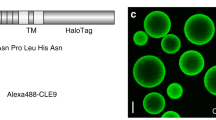Abstract
A photoaffinity analog of tomato leaf RALF peptide (LeRALF), 125I-azido-LeRALF, bound saturably to tomato suspension cultured cells in the dark in a classical receptor binding assay. Classical kinetic analyses revealed that the analog interacted with a single binding site on the surface of the cells with a KD of 0.8×10−9 M, typical of known peptide hormone–receptor interactions in both plants and animals. The 125I-azido-LeRALF, when exposed to UVB light in the presence of the cells, strongly labeled only two proteins of 25 kDa and 120 kDa, with the 25 kDa protein being more strongly labeled than the 120 kDa protein. The cell-surface localization of the interaction was indicated, as suramin, a known inhibitor of peptide–receptor interactions, and native LeRALF peptide competed with 125I-azido-LeRALF labeling of both proteins. Two biologically inactive LeRALF analogs were not competitors. Incubation of 125I-azido-LeRALF with suspension cultured cells in the dark, where it was fully active, could subsequently be totally dissociated from cells by acid washes, indicating that it was interacting at the cell surface and was not internalized. The 125I-azido-LeRALF-labeled 25 kDa and 120 kDa proteins could not be solubilized from cell membranes by methods that release peripheral proteins, indicating that they are integral membrane components. The cumulative kinetic and biochemical evidence strongly indicates that the two proteins may be components of a LeRALF receptor complex.






Similar content being viewed by others
References
Clark SE, Williams RW, Meyerowitz EM (1997) The CLAVAT1 gene encodes a putative receptor kinase that controls shoot and floral meristem size in Arabidopsis. Cell 89:575–585
Escobar NM, Haupt S, Thow G, Boevink P, Chapman S, Oparka K (2003) High throughput viral expression of cDNA-green fluorescent protein fusions reveals novel subcellular addresses and identifies unique proteins that interact with plasmodesmata. Plant Cell 15:1507–1523
Fletcher JC, Brand U, Running MP, Simon R, Meyerowitz EM (1999) Signaling of cell fate decisions by CLAVATA3 in Arabidopsis shoot meristems. Science 283:1911–1914
Germain H, Chevalier E, Caron S, Matton DP (2005) Characterization of five RALF-like genes from Solanum chacoense provides support for a developmental role in plants. Planta 220:447–454
Kachroo A, Nasrallah ME, Nasrallah JB (2002) Allele-specific receptor-ligand interactions in Brassica self-incompatibility. Plant Cell 14:227–238
Matsubayashi Y, Sakagami Y (1996) Phytosulphokine, sulphated peptides that induce the proliferation of single mesophyll cells of Asparagus officinalins L. Proc Natl Acad Sci USA 93:7623–7627
Matsubayashi Y, Pgawa M, Morita A, Sakagami Y (2002) An LRR receptor kinase involved in perception of a peptide plant hormone, phytosulfokine. Science 296:1470–1472
Meindl T, Boller T, Felix G (1998) The plant wound hormone systemin binds with the N-terminal part to its receptor but needs the C-terminal part to activate it. Plant Cell 10:1561–1570
Olson A, Mundy J, Skriver K (2002) Peptomics, identification of novel cationic Arabidopsis peptides with conserved sequence motifs. In Silico Biol 2:441–451
Pearce G, Ryan CA (2003) Systemic signaling in tomato plants for defense against herbivores: a single precursor contains three defense-signaling peptides. J Biol Chem 278:30044–30050
Pearce G, Strydom D, Johnson S, Ryan CA (1991) A polypeptide from tomato leaves activates the expression of proteinase inhibitor genes. Science 253:895–897
Pearce G, Moura DS, Stratmann J, Ryan CA (2001a) Production of multiple plant hormones from a single polyprotein precursor. Nature 411:817–820
Pearce G, Moura DS, Stratmann J, Ryan CA (2001b) RALF, a 5-kDa ubiquitous polypeptide in plants, arrests root growth and development. Proc Natl Acad Sci USA 98:12843–12847
Ryan CA, Pearce G, Scheer JM, Moura DS (2002) Polypeptide hormones. Plant Cell 14:251–264
Schaller A, Oecking C (1999) Modulation of plasma membrane H+ -ATPase activity differentially activates wound and pathogen defense responses in tomato plants. Plant Cell 11:263–272
Scheer JM, Ryan CA (1999) A 160 kD systemin cell surface receptor on Lycopersicon peruvanium cultured cells. Plant Cell 11:1525–1535
Scheer JM, Ryan CA (2002) The systemin receptor SR160 from Lycopersicon peruvianum is a member of the LRR receptor kinase family. Proc Natl Acad Sci USA 99:9585–9590
Schopfer CR, Nasrallah ME, Nasrallah JB (1999) The male determinant of self-incompatibility in Brassica. Science 286:1697–1700
Stratmann J, Scheer JM, Ryan CA (2000) Suramin inhibits initiation of defense signaling by systemin, chitosan, and a β-glucan elicitor in suspension-cultured Lycopersicon peruvianum cells. Proc Natl Acad Sci USA 97:8862–8867
Acknowledgements
This research was supported by National Science Foundation Grant IBN 0090766, and Washington State University College of Agriculture and Home Economics Project 1791.
Author information
Authors and Affiliations
Corresponding author
Rights and permissions
About this article
Cite this article
Scheer, J.M., Pearce, G. & Ryan, C.A. LeRALF, a plant peptide that regulates root growth and development, specifically binds to 25 and 120 kDa cell surface membrane proteins of Lycopersicon peruvianum. Planta 221, 667–674 (2005). https://doi.org/10.1007/s00425-004-1442-z
Received:
Accepted:
Published:
Issue Date:
DOI: https://doi.org/10.1007/s00425-004-1442-z




